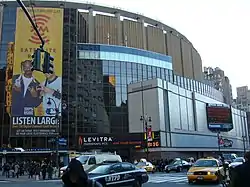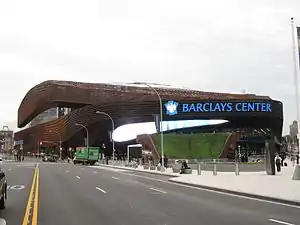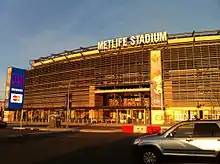69th Regiment Armory
The 69th Regiment Armory is a historic National Guard armory building located at 68 Lexington Avenue between East 25th and 26th Streets in the Rose Hill section of Manhattan, New York City. The building began construction in 1904 and was completed in 1906.[1][4] The armory was designed by the firm of Hunt & Hunt, and was the first armory built in New York City to not be modeled on a medieval fortress; instead, it was designed in the Beaux-Arts style.[4]
69th Regiment Armory | |
 (2010) | |

| |
| Location | 68 Lexington Avenue, Manhattan, New York City |
|---|---|
| Coordinates | 40°44′28″N 73°59′1″W |
| Built | 1906[1] |
| Architect | Hunt & Hunt[2] |
| MPS | Army National Guard Armories in New York State MPS |
| NRHP reference No. | 93001538 |
| NYCL No. | 1228 |
| Significant dates | |
| Added to NRHP | January 28, 1994[2] |
| Designated NHL | June 19, 1996[3] |
| Designated NYCL | April 12, 1983 |
The Armory was the site of the controversial 1913 Armory Show, in which modern art was first publicly presented in the United States, per the efforts of Irish American collector John Quinn.[4] It has a 5,000 seat arena that is used for sporting and entertainment events such as the Victoria's Secret Fashion Show. The Armory is also the former home of the Civil Air Patrol – Phoenix Composite Squadron. The building is still used to house the headquarters of the New York Army National Guard's 1st Battalion, 69th Infantry Regiment (known as the "Fighting Irish" since Gettysburg), as well as for the presentation of special events.
The building was declared a National Historic Landmark in 1965,[3][5] and a New York City landmark in 1983.[4]
Notable events

- In 1913, the Armory Show exhibited art from many contemporary artists such as Vincent Van Gogh, Pablo Picasso, Henri Matisse, Raoul Dufy, Marcel Duchamp, Andre Dunoyer de Segonzac, and more.[6] It was the first large-scale modern art show in the United States. It received mixed reactions from the public and media for its controversial new art forms, such as cubism, fauvism, and post-impressionism. It was a success and eventually moved on to Chicago and Boston.
- Thure Johansson of Sweden broke Dorando Pietri's indoor record for the marathon at the 69th Regiment Armory on March 1, 1910 (2:36:55.2).[7][nb 1] As of May 2010, the Association of Road Racing Statisticians notes that Johansson's mark still stands as the sixth fastest time on an indoor track.[8]
- Starting November 29, 1948 through early 1949, the Armory hosted at least 17 Roller Derby matches, including the first matches ever broadcast on television.[11]
- The Armory was the site of some New York Knicks home games from 1946 to 1960,[12]including all their home games during the 1951, 1952 and 1953 NBA Finals, due to other events being booked at the time at their normal home, Madison Square Garden. The New York Americans – now the Brooklyn Nets – of the new American Basketball Association wanted to play at the Armory in 1967, but pressure from the Knicks on the Armory management forced the new club to play in Teaneck, New Jersey, instead.
- In 1994, the rock group Soundgarden performed two shows at the Armory (on June 16 and 17), as part of the tour in support of their Superunknown album.
- In 1996, NBA Entertainment used the Armory to film Denzel Washington's portions of the documentary NBA at 50.
- After the September 11, 2001, attacks, the Armory served as a counseling center for the victims and families.[13]
- In 2002, 2003, 2005, 2009, 2010, 2011, 2012, 2013 and 2015 the Armory was the venue used for the Victoria's Secret Fashion Show.
- The Armory has been the site of the Museum of Comic and Cartoon Art's MoCCA Art Festival since 2009.
- The Architectural League of New York staged its annual "Beaux Arts Ball" at the Armory in 2013, to mark the centennial of the 1913 "Armory Show". For the event the ALNY commissioned giant illuminated cubist puppets designed by Processional Art Workshop[14][15]
- In May 2014, The Armory hosted the inaugural edition of the Downtown Fair in which work from leading art galleries was offered for sale.
See also
- List of New York City Landmarks
- National Register of Historic Places listings in New York County, New York
References
Explanatory notes
- There are a number of apparent inconsistencies in the available sources. The New York Times reported that Johansson later broke Peitri's mark of 2:44:20.4 which was set on November 28, 1908;[7] however, the data provided by the Association of Road Racing Statistician indicates three faster times were recorded in the interim leading up to the Crowley/Holmer/Johansson race.[8] Two days after their initial report, The New York Times published that there was "considerable discussion" that the race distance may have been short due to how the course was measured.[9] Although the Association of Road Racing Statisticians does not indicate any irregularity with the distance or performance, the International Association of Athletics Federations does not report Johannson's March 1, 1910, performance as a previous world best.[10]
Citations
- "69th Regiment Armory". 69th Regiment. Retrieved December 7, 2008.
- "National Register Information System". National Register of Historic Places. National Park Service. January 23, 2007.
- "69th Regiment Armory". National Historic Landmark summary listing. National Park Service. September 11, 2007. Archived from the original on October 13, 2007. Retrieved September 14, 2007.
- New York City Landmarks Preservation Commission; Dolkart, Andrew S.; Postal, Matthew A. (2009). Postal, Matthew A. (ed.). Guide to New York City Landmarks (4th ed.). New York: John Wiley & Sons. ISBN 978-0-470-28963-1., pp.87
- Prod, Nancy L.; Prol, Elbertus; Pitts, Carolyn; and Bearas, Edwin C. (November 1994) "National Historic Landmark Nomination: 69th Regiment Armory", National Park Service
- Brown, Milton W. (Milton Wolf), 1911-1998. (1988). The story of the Armory show (2nd ed.). New York: Abbeville Press. ISBN 0-89659-795-4. OCLC 17233619.CS1 maint: multiple names: authors list (link)
- "Swede's Marathon Makes New Record: Thure Johansen Wins Sensational Race From Crowley and Hobner". The New York Times. March 2, 1910. p. 10. Retrieved May 11, 2010.
- "All-Time Performances- Marathon Indoor Track"
- "Young Britt Beats Ty Cobb.; Dorando Challenges Johansen". The New York Times. March 4, 1910. p. 10. Retrieved May 12, 2010.
- "12th IAAF World Championships In Athletics: IAAF Statistics Handbook. Berlin 2009" (PDF). Monte Carlo: IAAF Media & Public Relations Department. 2009. p. 565. Archived from the original (PDF) on June 29, 2011. Retrieved May 11, 2010.
- Deford, Frank (1971). Five Strides on the Banked Track: The life and times of the Roller Derby. Little, Brown and Company. p. 89.
- Owens, Tom (2002). Basketball Arenas. Millbrook Press. p. 14. ISBN 0-7613-1766-X.
- Flynn, Sean. The Fighting 69th: One Remarkable National Guard Unit's Journey from Ground Zero to Baghdad, Penguin Books, 2007
- "Beaux Arts Ball 2013: –ism" on the Architectural League of New York website
- "The Architectural League's Beaux Arts Ball: –ISM on the Processional Art Workshop website
Source
- Murray, Cassie (April 12, 1983). Sixty-ninth Regiment Armory (PDF) (Report). New York City Landmarks Preservation Commission.
External links
| Wikimedia Commons has media related to 69th Regiment Armory. |
- Official website
- Official unit website - includes link to a slide tour of armory from the home page
- 69th Regiment
- NYC Architecture
- New York Times Article on the Commanders Room





